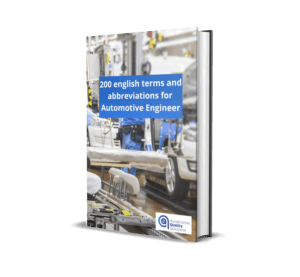During work in the industry, it’s important to know the automotive terms and abbreviations commonly used in this field. Below, we present 50 of them.
We hope this will provide valuable support for your work.
Download our free ebook 200 english terms and abbreviations for Automotive Engineer
Glossary of Terms and Abbreviations
5Why: A quality tool that helps gather as much information as possible for detailed root cause analysis. Used in step D4 of the 8D report.
8D Report: A troubleshooting method used when the root cause of a problem is unknown, requiring a team effort due to the severity and urgency of the issue.
Steps in 8D Analysis:
-
- D0: Problem Statement (+ERA: Emergency Response Action)
- D1: Team definition (recommended team composition and member tasks)
- D2: Problem definition (using facts)
- D3: Interim Corrective Actions (ensuring customer safety)
- D4: Root Cause definition
- D5: Choosing and planning permanent corrective actions (PCA)
- D6: Implementation and effectiveness assessment
- D7: Preventive actions
- D8: Conclusion and team congratulations
Advanced Manufacturing Engineering (AME): A department focused on launching and modifying production lines.
Best of the Best (BoB): Selecting parts for defined tests with optimal dimensional, performance, and functional results.
Critical Characteristic (CC): A characteristic related to safety or subject to government regulations, often monitored according to Statistical Process Control rules.
Control Plan (CP): A document specifying controls carried out from incoming inspection to final product audits, based on PFMEA outputs.
Control Shipment Level I (CSL I): 100% control performed by supplier staff at the customer’s request.
Control Shipment Level II (CSL II): 100% control performed by a provider approved by the customer.
Customer Specific Requirement (CSR): For more information, refer to the link.
Incidents Per Thousand Vehicles (IPTV): The number of notifications from the warranty field per 1,000 sold cars, used as a warranty indicator.
Just in Time (JIT): A method of delivering components (e.g., seats, dashboards, suspensions, bumpers) directly to the production line without storing them in the incoming warehouse.
Key Performance Indicators (KPI): Metrics used to meet IATF requirements. They should be considered in terms of effectiveness and efficiency wherever possible (see Sanctioned Interpretations).
Layered Process Audit (LPA): An audit performed at multiple levels to ensure compliance with quality system requirements. It also serves as a CSR for IATF requirement 9.2.2.3, Audit of the Manufacturing Process.
Lessons Learned (LL): Activities implemented after non-conformities occur, aimed at preventing recurrence in future projects, both in product design and production processes.
Left-Hand Drive (LHD): Parts used in vehicles with left-hand drive.
Mistake Proofing (MP): Equipment designed to detect non-conformities in manufactured products, ensuring issues are identified before shipment to the customer.
Non-Conforming Ticket (NCT): An official notification from the customer regarding identified quality or logistical non-conformities.
No Fault Found (NFF): A problem statement commonly used for warranty returns when analyses cannot reproduce the reported issue.
Original Equipment Manufacturer (OEM): A term for automotive industry customers who are members of the IATF Taskforce.
One Point Lesson (OPL): Created in response to customer complaints, typically as part of Interim Actions (ICA) and often used for employee training.
Open Issue List (OIL): A document created during plant process verification for new launches, where a dedicated team performs on-site verification.
Permanent Corrective Actions (PCA): Actions aimed at addressing the root cause of a problem. In the 8D report, these are defined in step D5.
Production Part Approval Process (PPAP): A process used to demonstrate that the supplier’s production process meets all customer requirements.
Parts Per Million (PPM): An indicator used by some customers and organizations to quantify the rate of complaints or non-conformities.
Production Validation Phase (PV): The phase prior to serial production, during which production processes and products are validated.
Poka Yoke (PY): A simple solution designed to eliminate the possibility of making mistakes.
RASI Chart: A matrix defined during contract signing that outlines responsibilities:
- R: Responsible party (e.g., customer).
- A: Approving party (e.g., customer or supplier).
- S: Supporting party (e.g., supplier or additional stakeholders).
- I: Informed parties about the given launch activities or ongoing production responsibilities.
Read Across (RA): An activity conducted to ensure controls in one plant are checked and applied across sister plants to prevent non-conformities.
Reproduced (Recreated) Problem: A critical step in analysis that confirms whether the problem is related to the manufactured product rather than external factors, such as the vehicle environment or incorrect dealer diagnosis.
Reoccurrence (of the Problem): In accordance with sanctioned interpretation (SI) no. 20 for IATF requirement 10.2.3 (Problem Solving), the organization must use methods that prevent the problem from recurring.
Right-Hand Drive (RHD): Parts specifically designed for right-hand drive vehicles.
Safe Launch Planning (SLP): A set of enhanced controls with increased frequency and part verification, differing from standard production controls, to ensure the success of new product launches.
Significant Characteristic (SC): Characteristics deemed critical by the customer, typically requiring a long-term capability index of 1.33 or higher.
Start of Production (SoP): The milestone marking the beginning of serial production. It signifies customer engineering consent for the production plant to produce vehicles for sale to end customers.
Total Productive Maintenance (TPM): A comprehensive approach to equipment management, combining maintenance activities with production team involvement to ensure equipment reliability and efficiency.
Technical Factor (TF): A performance indicator representing a percentage agreed upon between the customer and the organization, often as part of a rate guarantee.
Work in Progress (WIP): Semi-finished products on the production line (e.g., bumpers before painting or after injection molding).
Worst of the Worst (WoW): A selection of parts used for testing to identify the most critical issues.
Voice of Customer (VoC): Customer requirements and expectations, defined during both the development phase and ongoing production.
Voice of Process (VoP): Characteristics or functional controls derived from process data to proactively address and eliminate quality issues.
Download our free ebook 200 english terms and abbreviations for Automotive Engineer



